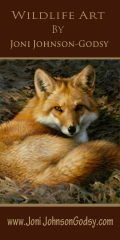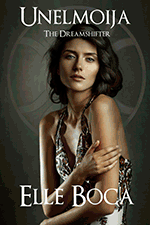by Editor | Jun 26, 2018 | Attractions, Ecotourism
By Elena del Valle
Photos by Gary Cox*

On a spring visit to the John and Mable Ringling Museum of Art in Sarasota, Florida we discovered the Mable Ringling Rose Garden (John and Mable Ringling Museum of Art, 5401 Bay Shore Road, Sarasota, Florida 34243, +1 941-359-5700 ext 2109, https://www.ringling.org/, Karen.smith@ringling.org). It was one of those sunny yet chilly and breezy days that is perfect for outdoor strolling. We saw the garden on our way to John and Mable’s storied home, now a museum, and made a point of stopping.

A signs described the history of the rose garden.
It was one of the highlights of our visit. I especially enjoyed the often fragrant flowers in 18 hues (the American Rose Society recognizes 18 colors of roses, a Ringling spokesperson explained by email), each with a name tag at the foot of the bush. The new name tags indicated if the rose was fragrant, Karen Smith, MSc., curator since 2015, Mable Ringling Rose Garden, explained when I asked about a particular flower a volunteer had suggested I see.
Flower fragrance is not a straightforward matter it turns out. It varies, according to the ratings of the American Rose Society, from Strong, Moderate and Mild, to None. So many roses were scented I was not surprised to discover 81 percent of the roses had some scent.

One of the paths lined with statues
At the time of our visit, excluding the miniatures and miniflora’s, 40 percent of the roses had a Strong scent, 19 percent Moderate, 22 percent Mild and 19 percent had no fragrance.
Ms. Smith is a former research scientist in the neuroscience field. Throughout thirty years in science, horticulture was always a part of her life. Care of the garden was no accident. Although she was the only employee dedicated to the garden when needed six estate gardeners were available to lend a hand. And 26 volunteers, including 15 seasonal visitors to the area, worked in the garden from three to 12 hours per month.

Karen Smith, MSc., curator, Mable Ringling Rose Garden

There are many challenges and stresses that can affect rose plants, the garden curator explained. She relies on Best Management Practices and a weekly monitoring system during which more than 100 bushes are inspected each week.

“A rating is given for pests and diseases,” she said by email. “If it is determined that the disease or pest is at a level that is unacceptable, treatment occurs. We use the safest treatment possible for each situation. For example when the weather is cool enough we will use Neem Oil as our pesticide for Aphids, Mites, Thrip, and Scale. Every spring we remove the old mulch and bring in 75 cubic yards of compost, fertilize, and re-mulch
When asked for fertilizer specifics she shared details generously, “Currently for fertilizer we use a 4-3-4 Turkey Manure (Mighty Grow) and 16-0-0 Blood meal – each four times a year. Supplement with a Sul-Po-Mag (0-0-22) twice a year. For example to fertilize once using the Mighty Grow takes 650 lbs.”

What are the best months to see the roses in bloom and at their most fragrant? December and January as well as March and April. In 2017 Hurricane Irma caused some damage to the garden so it was not at its prettiest during our visit.

“We have two cut-backs a year, one in February and one in September, the garden curator said. “The large blooms occur approximately 8 weeks after cutback. It take us 3 weeks to complete the cutback- therefore the bloom is in phases comparable to the cutback.”

Many visitors strolled through the garden on the day of our visit.
We later discovered the garden dates back to 1913. Sadly, none of the plants from Mable’s era remain. The garden consists of 1,200 rose plants introduced between 1793 and 2002, among them Tree Roses, Hybrid Teas, Floribundas, Grandifloras, miniature roses, shrubs, Old Garden Roses (varieties introduced prior to 1867). Among them was a rose dedicated to Mable.

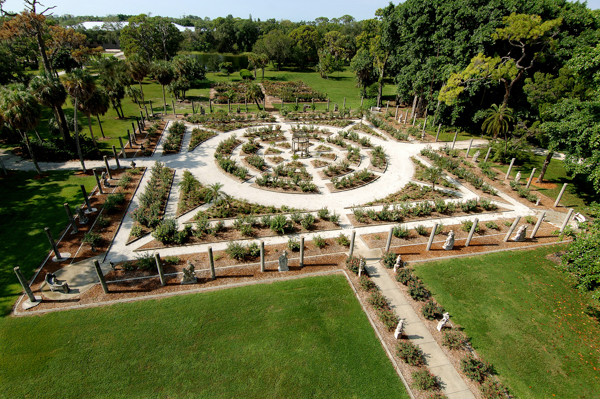
The Italian inspired Rose Garden has a circular wagon wheel design.
(Click photo to view full size)
The 27,225 square foot Italian inspired Rose Garden has a circular wagon wheel design and pathways lined with garden sculptures of courting couples in pastoral scenes. By the late 1930s the estate and the garden fell into disrepair. Many years passed before it returned to a state similar to the one we saw during our visit. By 2004 the garden was restored thanks to the efforts of the resident horticulturist, Ron Mallory and the volunteers he recruited.
It received accreditation from the All-American Rose Selections in 2004, and recognition in 2006 as the most outstanding All-American Rose Selections Public Rose Garden in the nation.
*Aerial photo of the Rose Garden (date unknown) courtesy of the John and Mable Ringling Museum of Art
by Editor | Sep 25, 2017 | Attractions, Ecotourism
By Elena del Valle
Photos by Gary Cox

The Berlin Falls in Mpumalanga, South Africa
On a recent safari trip to South Africa earlier this year we had an opportunity to visit the Blyde River Canyon. One of the owners of the Belgrace Boutique Hotel, who also owned a tour company, invited us to a half day visit of the area as part of our transfer from his hotel to our safari property. Visiting the canyon required us to leave extra early. Our efforts were rewarded as the parking lot at the first of our stops was nearly deserted, except for curio vendors setting up for the day and staff cleaning the public bathrooms.

It was a little hazy, but the view from the God’s Windows lookout was breathtaking.
According to SouthAfrica.net, the 29,000 hectare Blyde River Canyon Nature Reserve is carved out of red sandstone and is one of South Africa’s most remarkable geological features. Salient areas of the “green canyon” we saw were the Three Rondavels or Three Sisters, God’s Window and Bourke’s Luck Potholes.

Over time the flow of water carved out circular “potholes” in the limestone of the valley.

The river flows rapidly just above the potholes.

The same photo with a long exposure filter to smooth the water (just for fun)
The further along we progressed the more tourists we encountered, including several buses packed with travelers speaking foreign tongues. There were also more curio vendors in make shift structure and later inside a building. In lieu of lunch we snacked on locally produced cashews, macadamia nuts and dried fruits from a plastic container our tour escort brought with him. There were also chilled juices and water.

The Three Rondavels were our final stop as we made our way through the canyon.

The series of attractions were part of the Blyde River Canyon Nature Reserve
The added attractions were worth the extra effort and time. Although we had few moments to spare for much beyond photos and quick rest stops we enjoyed the sights and the opportunity to see yet another beautiful natural wonder in the vast country full of natural treasures.
by Editor | Aug 28, 2017 | Attractions, Ecotourism
By Elena del Valle
Photos by Gary Cox

Jabulani, the camp’s namesake, at The First Meeting in May 2017
On our first visit to Camp Jabulani, a Five Star lodge near South Africa’s famed Kruger National Park, in 2008 we met some of the house elephants who had been raised or rescued by humans. After the young Jabulani, born in 1997, was abandoned by his elephant relatives when he became stuck in the mud the owners of the privately owned Big Five Kapama Reserve opened their hearts and their pockets to adopt him. In 2004, they established Camp Jabulani. When a herd of elephants in neighboring Zimbabwe was marked for slaughter they intervened, relocating the herd to their property.

Left to right: Matipedza Tigere, elephant manager, and another staff member at The First Meeting, part of The Camp Jabulani Elephant Experience

A staff member showed us how to feed the pachyderms pellets via the elephant’s trunk.
On that visit we met the whole herd, watched the staff tuck them in for the night and, most memorable of all, went elephant back riding. Earlier this year only weeks before our return, Camp Jabulani stopped offering elephant back rides. We wondered how the changes would affect our visit. We need not have worried as we had a comfortable stay and rewarding elephant experience at the luxury lodge.

A closeup look at the elephant’s huge molars
“Camp Jabulani is a rather special lodge as it was established with the sole purpose of providing and income to look after Jabulani and a herd of elephants rescued from Zimbabwe in 2002,” Christo Rachmann, general manager, explained. “Currently the cost of looking after our elephants is around R450 000,00 per month. By visiting Camp Jabulani guests are actively contributing to the well-being of these magnificent animals.”

A closeup of the elephant’s huge eye and very long lashes was surprisingly difficult to photograph.
During our two night in stay in May 2017 we had The Camp Jabulani Elephant Experience. The day we arrived we had The First Meeting, part of The Camp Jabulani Elephant Experience. We spent a few minutes with Jabulani and another even larger young male. Under the watchful eye of Matipedza Tigere, elephant manager, we fed them pellet snacks, touched their skin and took photos. They smelled us with the tip of their trunk, quickly picked the pellets directly from our hands and let us run our hand along their side with surprising calm. Jabulani wrapped his trunk around my waist and dragged me gently yet firmly to one side (it was impossible to hold my position) until the elephant manager intervened.

The elephant manager explained how an elephant’s foot carries its heavy body yet makes soft sounding footsteps.
Such nearness could give the false impression that elephants are easy to approach. Many safari trips have taught me that is far from true. I have a deep respect for the gentle giants. The elephants and the elephant manager’s relaxed demeanor reassured me as did his instructions. Tigere, a native of Chinhoyi, Zimbabwe, had 18 years of experience, and had a Field Guides Association of Southern Africa (FGASA) Level One Theory rating. He had been at Camp Jabulani since 2008. If he said it was safe to interact with the two huge creatures I believed him.
Because of the rescued elephants unique background the herd developed a positive atypical family structure. The staff explained that there are strong ties between male and female animals, and clearly established matriarchs have assumed responsibility for all infants, their own (five babies were born to the herd), as well as that of new orphans. The babies that have arrived in the last five years were successfully introduced to the herd with minimal human intervention. According to promotional materials, the managers and owners of Camp Jabulani planned to continue to rescue and rehabilitate elephants in need.

The youngest member of the herd was curious about our vehicle when we came to watch them play in the water
The following day at noon we waited for the 15 semi-tame elephants of the house herd to enter the water hole, hoping they would bathe. That was the In Their Element activity, also part of The Camp Jabulani Elephant Experience. We watched from our vehicle and they watched us back, curious. When playful elephants approached our vehicle our guide reversed, avoiding contact. A couple of times he revved the loud engine to make a particularly nosy elephant retreat. When we asked if there was danger he explained that wasn’t the case. They were curious about us and wanted to explore. The problem was that if an elephant brushed the new vehicle with its trunk it would damage the paint.

These younger members of the herd wrestled and played while we watched

On the way to their pens for the night, the elephants paraded past our sun downer spot.
We watched the herd feed and interact. A number of elephant handlers sat around on the ground. We waved hello and they waived back. They called the youngest elephant to one side where they fed her a special extra nutritious blend from a bucket. For whatever reason the herd didn’t go in the water that afternoon. I didn’t mind much. Watching them so calm and playful was enough for me. A few minutes later the handlers rose to their feet, calling the herd away. As we drove back to Camp Jabulani I smiled. Our stay at the luxury property had been a pleasure, and seeing the elephants in close proximity the way we had was one of the main reasons.

by Editor | Jun 19, 2017 | Attractions, Luxury Travel
By Elena del Valle
Photos by Gary Cox

Sunset over the gulf on Anna Maria Island
For some reason I had it in my mind that Anna Maria Island, an island with three distinct municipalities off the coast of Bradenton, Florida, would be a sleepy relaxed vacation place. Sleepy it was not. We visited during the low season and it was bustling with people (and some pets), especially on the wide white sand beach. While there was a permanent resident population (1,814 residents and 1,098 single family homes in the City of Anna Maria, according to its website) the island was highly touristy. The density of houses and number of new construction projects surprised us.

An osprey caught our attention while we were walking on the beach
Although we walked the length of the beach from north to south and south to north, we spent the majority of our time in the north end of Holmes Beach and the City of Anna Maria. Both were more residential than commercial as well as quieter and less crowded, by comparison, than the south end of Holmes Beach and Bradenton Beach. Visitors and residents made their way around the island on foot for short distances. Cars, golf carts and a complimentary trolley (a full size air conditioned bus when we were there) with frequent stops over most of the island shared the few roads. A favorite option was to ride the trolley to the end of the line on the southern tip of Anna Maria Island, and walk along the beach all the way north or to our beachfront rental. We also walked south and returned via the trolley, but it meant facing the hot sun for most of the walk south so we preferred riding the trolley south and walking north.

The Anna Maria City Pier was popular

The Anna Maria City Pier Restaurant surrounded by people fishing
In the City of Anna Maria, we liked Pine Avenue for window shopping. The Anna Maria City Pier, on the east end of Pine Avenue, was fun of people watching and strolling. From the pier we could see the mainland in the east. And below the surface the water was so clear we could see fish and pale sand at the bottom. At the end of the pier, people with a variety of regional accents, some speaking European languages, fished contently. We especially appreciated that the entire city was a bird sanctuary.

The water was clear and inviting
For a sweet treat there was Hometown Desserts (507B Pine Avenue, Anna Maria, Florida 34209, +1 941 896-3167), a tiny shop off Pine Avenue, the main road, where I bought cookies, key lime pie, cup cakes and coconut macaroons (a gluten free option). For an alfresco lunch we liked The Waterfront Restaurant and Craft Bar (111 South Bay Boulevard, Anna Maria, Florida 34216, +1 941-778-1515, https://thewaterfrontrestaurant.net/, info@thewaterfrontrestaurant.net), across the street and half a block south from the pier. It offered friendly service and seating indoors and on a shady outdoor deck facing the bay. It was popular on weekends. We had to wait an hour Friday afternoon for a table on the covered terrace.

The local grocery and deli on Pine Avenue in the City of Anna Maria
In general, the firm white powdery beach was our favorite feature on the island. In the predawn hours and as the sun was rising many people walked and jogged along the shore. Despite the wide beach it felt crowded at times yet it was pleasant and surprisingly clean. As the sun advanced in the sky more beach lovers arrived with chairs, umbrellas and snacks to settle in for a several hours. Few went in the clear chilly water. Some collected seashells or made sandcastles. Later as the sun waned a batch of sun lovers made their way to the seashore to catch a glimpse of the sunset. Waiting for the golden orb to dip beyond the horizon became one of our daily treats.

The Waterfront Restaurant and Craft Bar was a favorite for alfresco dining

The grouper sandwich
Our stay on Anna Maria Island was pleasant and worth repeating. I would return to the City of Anna Maria and Holmes Beach for its pretty white sand beach, relaxed resort style ambiance, upscale accommodations and natural setting.

by Editor | May 15, 2017 | Accomodations, Attractions, Luxury Travel, Restaurants, Spas
By Elena del Valle
Photos by Gary Cox

A typical dreary day by Lake Titisee during our visit
We planned our week long trip to the Black Forest Highlands in Germany months in advance with the expectation that a spring itinerary would reward us with dry and sunny weather. Instead it our visit in June 2016 was far wetter, colder and foggier than we had anticipated. It rained on and off most of the day every day during our whole stay in the area, forcing us to revise our plans entirely. In lieu of trekking on mountain tops and cable cars we spent our days in our hotel room waiting for the rain to stop or remained indoors, dining, in museums, and churches for the duration of our visit.

The clock museum featured displays of clock history

Tools used to automate the creation of the gears and wheels were featured
We replaced nearly all our outdoor activities with indoor ones. The two lane mountain roads, slick from the rain and filled with impatient drivers, did nothing to improve the situation. In the end, we made the most of the situation, exploring as best as possible in moments of respite from the constant showers. We seldom encountered English speakers or materials in English, making it necessary for us to rely on our guide frequently to translate menus at restaurants and information sheets at attractions.

The Parkhotel Adler in Hinterzarten was a favorite for its luxury facilities and spa
From the airport we drove to the Parkhotel Adler in Hinterzarten. It was the most luxurious of the properties we visited that trip. I spent time at Hoffmann Beaute & Physiontherapie, its serene spa. Because of the cool temperatures and showers I was thankful for the property’s underground hallways that connected its facilities and provided us indoor access to the hotel spa and restaurants in adjacent buildings.

The lake fronting Seecafé in Schluchsee
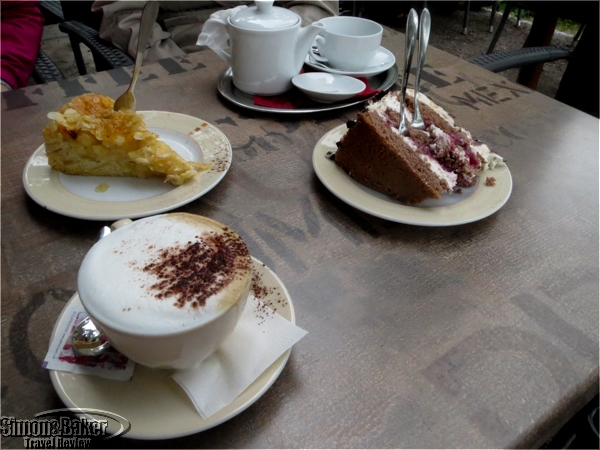
We had Black Forest cake, strudel cake and cappuccino by the lake
The first attraction we visited was the Deutsches Uhrenmuseum (German Clock Museum at Robert-Gerwig-Platz d-78120 Furtwangen, +49 7723-920 2800, deutsches-uhrenmuseum.de) northeast of Freiburg. It was a fun way to spend the morning and learn about the history of clock making in Germany.

We spent the weekend at the popular Treschers Schwarzwald Romantic Hotel
One afternoon, to satisfy our sweet tooth we stopped at the Seecafé (Im Wolfsgrund 26, 79859, Schluchsee, +49 76 56/98 88 97), where we indulged in hot beverages and huge slices of regional specialties such as Black Forest chocolate cake. Despite the chilly temperatures we enjoyed the Schluchsee lakeside setting and terrace seating until a steady flow of raindrops forced us to leave.

We were delighted with our first sunny hour from the patio at Boutique-Hotel Alemannenhof
In the Lake Titisee area we stayed at two family owned properties. We spent the weekend at the popular, lake fronting Treschers Schwarzwald Romantic Hotel (see Our weekend stay at Black Forest lake front hotel with spa) with a spa in the highly touristy town of Titisee. When our rental apartment plans fell through the friendly owners and staff at the charming and lovingly built Boutique-Hotel Alemannenhof squeezed us in at the last minute without hesitation. The hotel, the Drubba Monument Shopping stores on the pedestrian street in Titisee, and the Hofgut Sternen hotel and adjacent shops were the property of the enterprising Drubba Family. It was at one of their shops where we watched a demonstration about the making of the famous cuckoo clocks. At another we caught the end of a glassblowing demonstration. Their hillside property was a favorite for its Lake Titisee views and foodie orientation.

One of the hand-carved carnival masks at Holzmasken Stiegeler in Grafenhausen
In Grafenhausen, we liked the hand-carved carnival masks at Holzmasken Stiegeler (see Black Forest shop carried on with wood carved mask tradition). In Grafenhausen-Rothaus, we visited Hüsli or small house (79865 Grafenhausen-Rothaus, Am Hüsli 1 im Naturpark Südschwarzwald, + 49 77 48/212, www.hüsli-museum.de), a folk art museum dating back to 1912 when actress Helene Siegfried built a summer home from second-hand materials. We also toured the Rothaus (Badische Staatsbrauerei Rothaus AG, Rothaus 1, 79865 Grafenhausen-Rothaus, +49 7748/522-0, www.rothaus.de, info@rothaus.de) brewery museum, a modern facility with self-guided tours, where we sampled locally produced beer and bought souvenirs at the small shop.
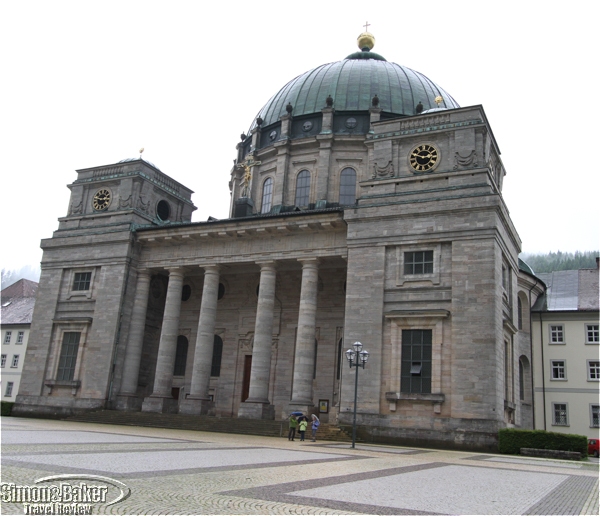
St. Blasien Cathedral, a lovingly maintained structure 36 meters wide and 62 meters high

The interior of St. Blasien Cathedral

The St. Blasien Cathedral cupola
We visited several churches while in the Black Forest Highlands. Salient among them for sheer size and the determination of its builders was St. Blasien Cathedral, a pretty and lovingly maintained structure 36 meters wide and 62 meters high. The early classical cupola is the largest of its kind north of the Alps.

Our final nights were at the Hotel Adler in Häusern

The sun made an appearance on our last afternoon in the Black Forest
Our final nights were at the Hotel Adler in Häusern, where we dined at the hotel’s gourmet restaurant (see Dinner at Black Forest Highlands gourmet restaurant). We would recommend the Black Forest Highlands to friends who speak German or don’t mind seeking translations, like moderate luxury in a heavily touristy area with authentic regional cuisine, enjoy mountainous landscapes and the outdoors, and are able to change plans in a hurry if the weather turns ugly.

by Editor | May 1, 2017 | Attractions, Luxury Travel
Article and photos by Scott S. Smith

London’s vast British Museum is the oldest public museum in the world
My wife and I thought we could run through a refresher on London’s British Museum when we visited for the second time in September 2016 (Great Russell Street, +44 020 7323 8000, www.britishmuseum.org, info@britishmuseum.org). We had taken a full two days 35 years before when we were last there, but figured four hours would be enough to hit the highlights. Relying on the invaluable DK Eyewitness Travel Guides London, with additional tips from Rick Steves’ Pocket London and checking the website, we boiled down the list to just the must-see-agains and some we had overlooked or which had not been on display (we belatedly discovered that only one percent of its 50,000 items are exhibited at any one time). Despite the name, this is really the greatest museum in the world on the history of the ancient world, thanks to plundering by colonial officials who had the classical education to appreciate what they brought back. As if that weren’t enough, it also has artifacts up to the present day. Established in 1753 to house a private collection, the main current building was completed in 1850, and the entire complex of 94 galleries on three levels occupies a total of 2.5 miles. We recommend to our friends visiting for the first time that they take one of the highlight tours and set aside at least one full day for the museum. To avoid crowds, we will visit weekday afternoons.
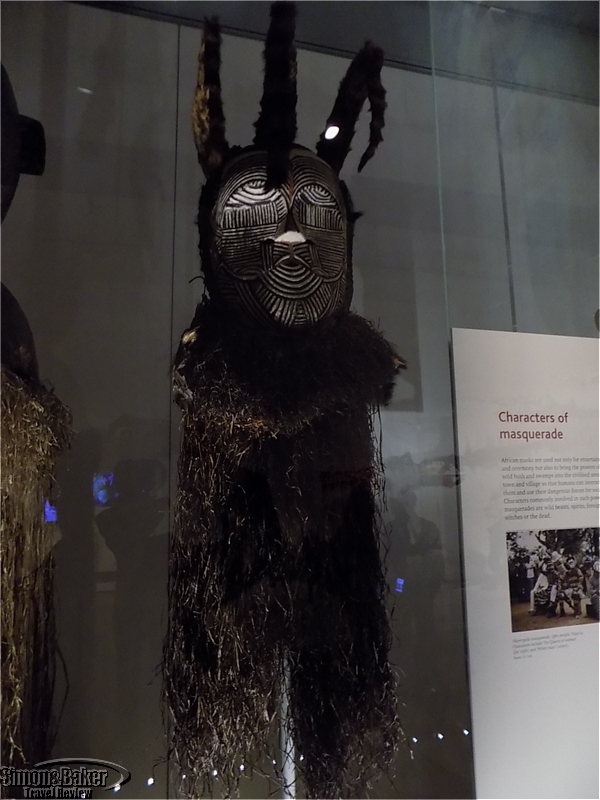
A 19th century priestly mask from the Songye people in the Democratic Republic of the Congo
We found the lower floor (basement) of the British Museum was overlooked because it is primarily devoted to Africa, while the other two floors had many world-class treasures. But African art has always been a favorite of ours when we go to any major museum of world culture. The African imagination has always struck us as astonishing, perhaps unleashed by its magical view of reality. The ritual masks, costumes, and statues are always better than anything we’ve ever seen near our home in West Hollywood, California, at the Halloween street parade, which is saying something (it draws half a million participants and spectators due to the creative contributions from movie professionals). This time, we particularly liked a multi-horned headdress for ancestral ceremonies from 19th century Nigeria and some famous bronze statues from the Kingdom of Benin.

A Centaur and Lapith wrestle in a relief from the Parthenon
Back on the ground floor, we headed straight to the enormous room displaying the Elgin Marbles, décor from the Parthenon, the temple of Athena on the Acropolis in Athens, which the British brought back in 1816 and the Greeks have been trying ever since to get returned. Despite thousands of years of wear from exposure, they still showed the brilliant skills of the sculptors during the Golden Age of Greece (500-430 B.C.), the cultural supernova that led to the Renaissance and Western civilization (the best summary of their contribution is Edith Hamilton’s The Greek Way). We also saw many other gorgeous sculptures and ceramics from the Greeks and Romans in other galleries and on the upper floor.

Human-headed winged bulls from the Palace of Sargon II at Khorsabad, Assyria (near Mosul, Iraq)
The ground floor also had much from the ancient Middle East, especially Assyria. There were several sets of enormous winged-bulls that guarded the palaces of Sargon II, who reigned 721-705 B.C. and according to the Bible took the northern 10 tribes of Israel into captivity (now referred to as the Ten Lost Tribes, they were said to have “gone north” after Assyria’s fall, but may have simply blended in with other peoples in the region). One famous relief depicted the royal sport of lion hunting, and there were artifacts from ancient Jericho and Islamic cultures. More from the Middle East, especially Iran, was on the upper floors, but we just breezed through it for lack of time. The collection for the Americas was confined to two modest rooms, but had some outstanding sculptures from ancient Meso-American peoples, such as the Zapotecs. As for the rest of the floor, having been to India and Japan, and having little interest in China, we skipped the Asian section.

Coffin of Egyptian incense bearer Denytenanum, Temple of Amun, Thebes (9th century B.C.)
The upper floor’s Egyptian section may be the world’s best outside of the Cairo Museum (which we’ve been to). It is world famous for having the Rosetta Stone, carved into which was a trilingual inscription that enabled the French to begin to decipher the hieroglyphics. It was hard to photograph through the glass and the writing is tiny, but there was a model nearby we could touch. Another outstanding item was the enormous statue of Ramesses II, the 13th century pharaoh many believe was the one who reluctantly let the Israelite slaves leave Egypt. There were also numerous mummies and painted coffins.

Zapotec funerary urn from Mexico from about 200 B.C.
The other primary section on the upper level we were interested in was for Britain, covering as far back as 10,000 B.C. The most striking item was the 2,000-year-old Lindow Man, who was sacrificed in a ritual way, his skin preserved in a peat bog in Cheshire. The other big draw was the burial of a 7th century A.D. Anglo-Saxon king in a ship filled with treasures at Sutton Hoo, East Anglia, discovered in 1936. Among the many notable items, which revolutionized understanding of the era, were a ceremonial helmet, a shield, gold jewelry, silver bowls, and a lyre, a harp-like instrument. Now that we have been reminded of how incredible the British Museum is, we will not take another 35 years to return and will give it the time it needs to be fully appreciated in the future. There is a reason it is the top tourist destination in Britain.


























































